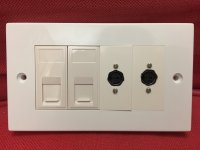cheesestraws
Well-known member
I'm probably going to install LocalTalk cabling in my new office/workroom while I install Ethernet, because it means I don't have cabling thrown across the room while I'm experimenting and it won't be much extra effort.
Has anyone here run LocalTalk over CAT5/6? As far as I can see it ought to work fine: the signal integrity ought to be fine, and CAT5/6 has a characteristic impedance of ~100ohms which matches the termination in LocalTalk boxes.
The sensible (hah) option here would be to get telephone-type wiring installed and just use PhoneNet, but I don't have any PhoneNet equipment, and also mini-DINs look cool...
Has anyone here run LocalTalk over CAT5/6? As far as I can see it ought to work fine: the signal integrity ought to be fine, and CAT5/6 has a characteristic impedance of ~100ohms which matches the termination in LocalTalk boxes.
The sensible (hah) option here would be to get telephone-type wiring installed and just use PhoneNet, but I don't have any PhoneNet equipment, and also mini-DINs look cool...

